Organisational Behaviour Report: Leadership and Motivation at M&S
VerifiedAdded on 2023/01/18
|15
|4794
|63
Report
AI Summary
This report provides a comprehensive analysis of organisational behaviour within Marks & Spencer (M&S). It begins by examining how organisational culture, politics, and power influence the behaviour and performance of individuals and teams, using Handy's typology of culture to categorize M&S's culture. The report then delves into motivational theories, differentiating between content and process theories, with a focus on Maslow's hierarchy and ERG theory. Furthermore, it explores the characteristics of effective and ineffective teams, providing insights into team dynamics. Finally, the report applies concepts and philosophies of organisational behaviour to the context of M&S, drawing conclusions about the impact of these factors on the company's overall performance. The report considers the impact of various factors on employee motivation and productivity within the organization. The report is structured to examine the impact of organizational culture, politics, power, and motivational theories on employees and teams within the company, including discussion of effective and ineffective team dynamics.
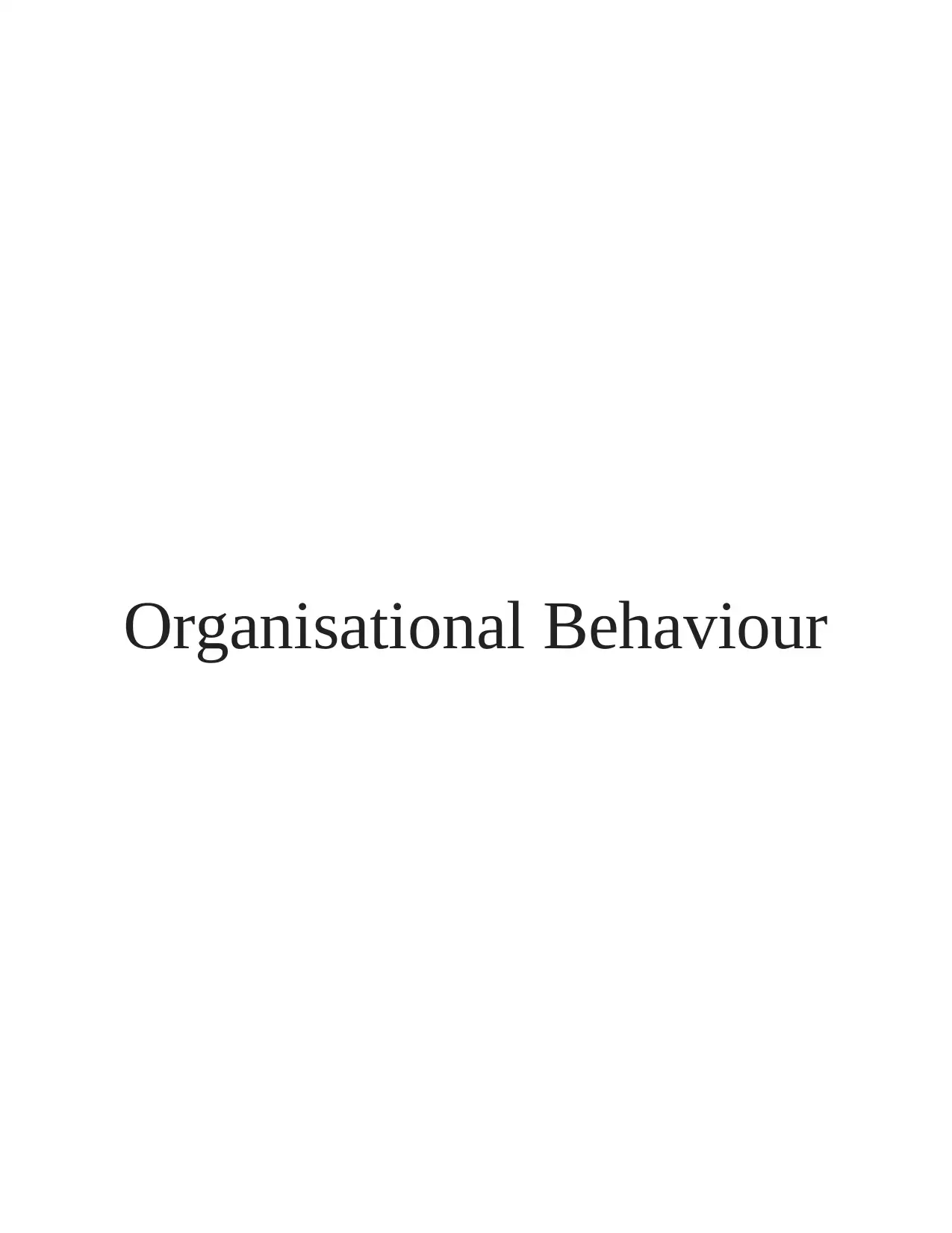
Organisational Behaviour
Paraphrase This Document
Need a fresh take? Get an instant paraphrase of this document with our AI Paraphraser
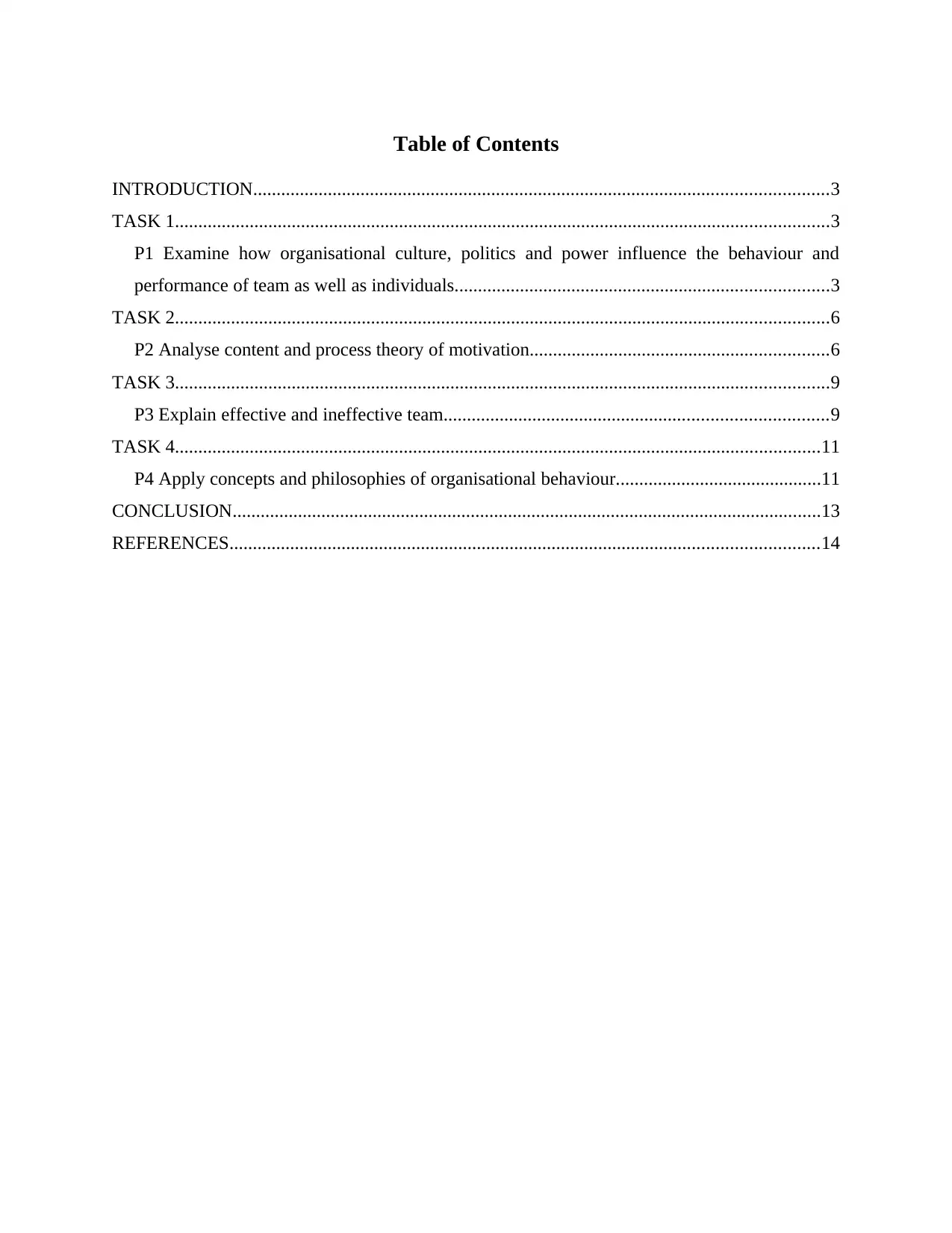
Table of Contents
INTRODUCTION...........................................................................................................................3
TASK 1............................................................................................................................................3
P1 Examine how organisational culture, politics and power influence the behaviour and
performance of team as well as individuals................................................................................3
TASK 2............................................................................................................................................6
P2 Analyse content and process theory of motivation................................................................6
TASK 3............................................................................................................................................9
P3 Explain effective and ineffective team..................................................................................9
TASK 4..........................................................................................................................................11
P4 Apply concepts and philosophies of organisational behaviour............................................11
CONCLUSION..............................................................................................................................13
REFERENCES..............................................................................................................................14
INTRODUCTION...........................................................................................................................3
TASK 1............................................................................................................................................3
P1 Examine how organisational culture, politics and power influence the behaviour and
performance of team as well as individuals................................................................................3
TASK 2............................................................................................................................................6
P2 Analyse content and process theory of motivation................................................................6
TASK 3............................................................................................................................................9
P3 Explain effective and ineffective team..................................................................................9
TASK 4..........................................................................................................................................11
P4 Apply concepts and philosophies of organisational behaviour............................................11
CONCLUSION..............................................................................................................................13
REFERENCES..............................................................................................................................14
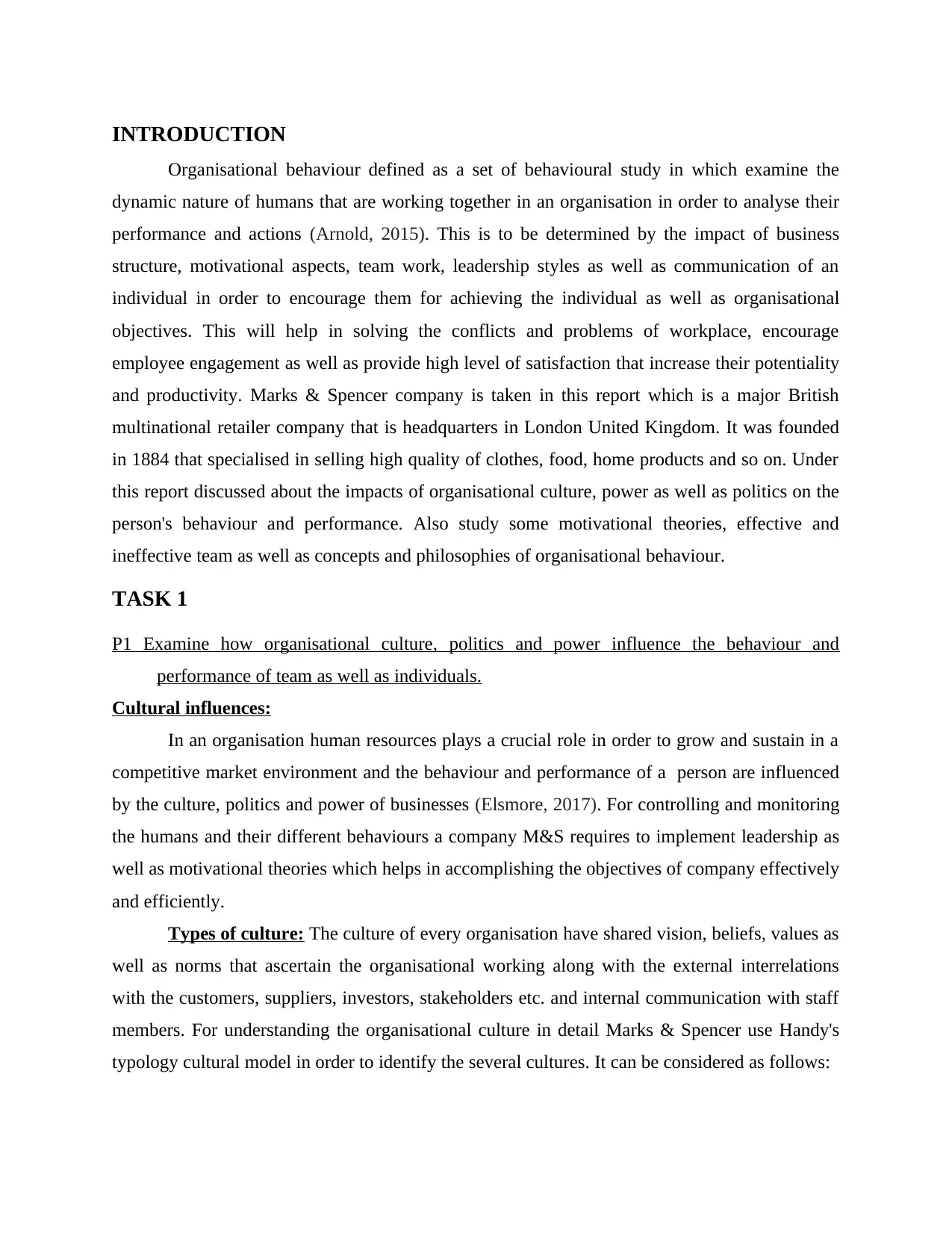
INTRODUCTION
Organisational behaviour defined as a set of behavioural study in which examine the
dynamic nature of humans that are working together in an organisation in order to analyse their
performance and actions (Arnold, 2015). This is to be determined by the impact of business
structure, motivational aspects, team work, leadership styles as well as communication of an
individual in order to encourage them for achieving the individual as well as organisational
objectives. This will help in solving the conflicts and problems of workplace, encourage
employee engagement as well as provide high level of satisfaction that increase their potentiality
and productivity. Marks & Spencer company is taken in this report which is a major British
multinational retailer company that is headquarters in London United Kingdom. It was founded
in 1884 that specialised in selling high quality of clothes, food, home products and so on. Under
this report discussed about the impacts of organisational culture, power as well as politics on the
person's behaviour and performance. Also study some motivational theories, effective and
ineffective team as well as concepts and philosophies of organisational behaviour.
TASK 1
P1 Examine how organisational culture, politics and power influence the behaviour and
performance of team as well as individuals.
Cultural influences:
In an organisation human resources plays a crucial role in order to grow and sustain in a
competitive market environment and the behaviour and performance of a person are influenced
by the culture, politics and power of businesses (Elsmore, 2017). For controlling and monitoring
the humans and their different behaviours a company M&S requires to implement leadership as
well as motivational theories which helps in accomplishing the objectives of company effectively
and efficiently.
Types of culture: The culture of every organisation have shared vision, beliefs, values as
well as norms that ascertain the organisational working along with the external interrelations
with the customers, suppliers, investors, stakeholders etc. and internal communication with staff
members. For understanding the organisational culture in detail Marks & Spencer use Handy's
typology cultural model in order to identify the several cultures. It can be considered as follows:
Organisational behaviour defined as a set of behavioural study in which examine the
dynamic nature of humans that are working together in an organisation in order to analyse their
performance and actions (Arnold, 2015). This is to be determined by the impact of business
structure, motivational aspects, team work, leadership styles as well as communication of an
individual in order to encourage them for achieving the individual as well as organisational
objectives. This will help in solving the conflicts and problems of workplace, encourage
employee engagement as well as provide high level of satisfaction that increase their potentiality
and productivity. Marks & Spencer company is taken in this report which is a major British
multinational retailer company that is headquarters in London United Kingdom. It was founded
in 1884 that specialised in selling high quality of clothes, food, home products and so on. Under
this report discussed about the impacts of organisational culture, power as well as politics on the
person's behaviour and performance. Also study some motivational theories, effective and
ineffective team as well as concepts and philosophies of organisational behaviour.
TASK 1
P1 Examine how organisational culture, politics and power influence the behaviour and
performance of team as well as individuals.
Cultural influences:
In an organisation human resources plays a crucial role in order to grow and sustain in a
competitive market environment and the behaviour and performance of a person are influenced
by the culture, politics and power of businesses (Elsmore, 2017). For controlling and monitoring
the humans and their different behaviours a company M&S requires to implement leadership as
well as motivational theories which helps in accomplishing the objectives of company effectively
and efficiently.
Types of culture: The culture of every organisation have shared vision, beliefs, values as
well as norms that ascertain the organisational working along with the external interrelations
with the customers, suppliers, investors, stakeholders etc. and internal communication with staff
members. For understanding the organisational culture in detail Marks & Spencer use Handy's
typology cultural model in order to identify the several cultures. It can be considered as follows:
⊘ This is a preview!⊘
Do you want full access?
Subscribe today to unlock all pages.

Trusted by 1+ million students worldwide
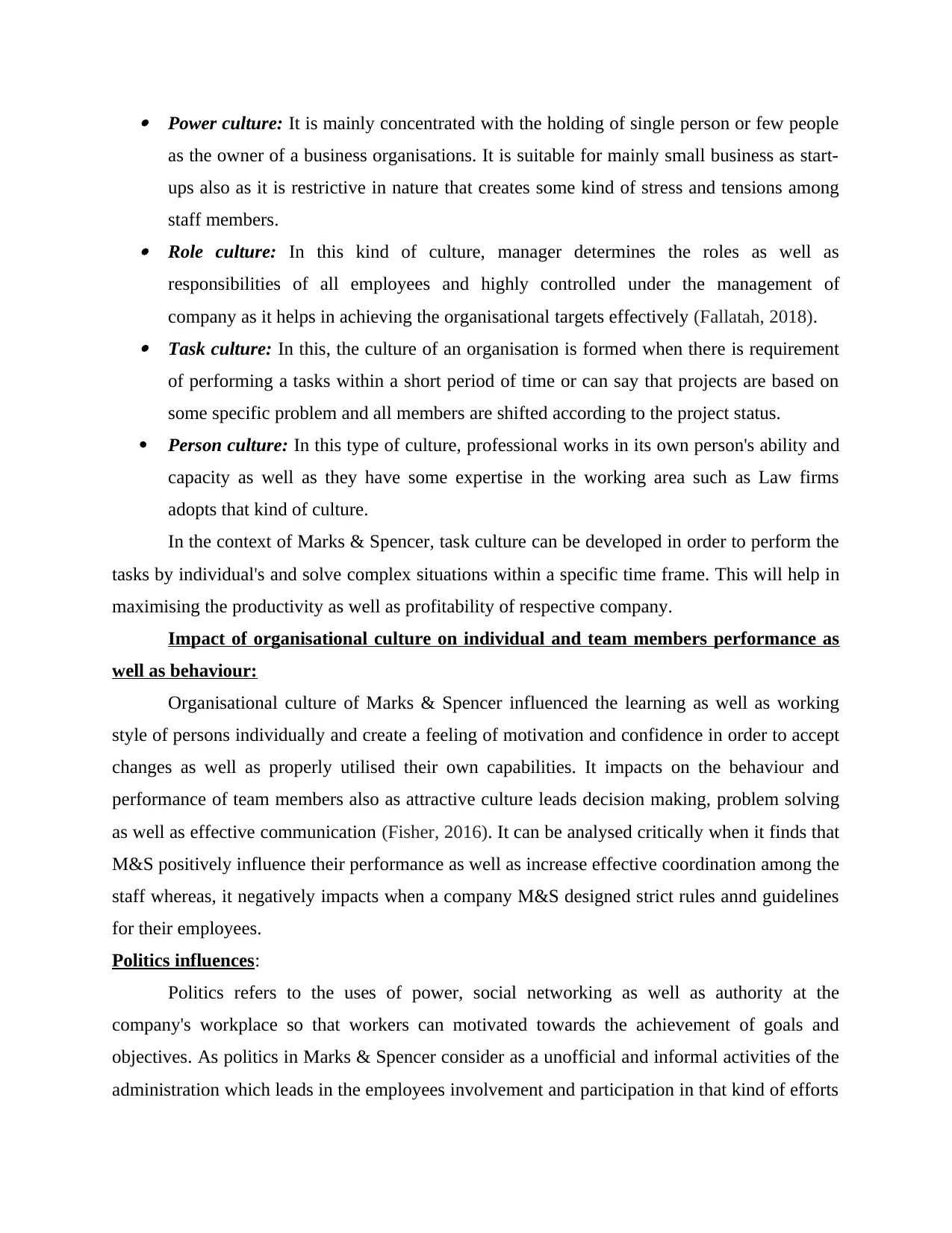
Power culture: It is mainly concentrated with the holding of single person or few people
as the owner of a business organisations. It is suitable for mainly small business as start-
ups also as it is restrictive in nature that creates some kind of stress and tensions among
staff members. Role culture: In this kind of culture, manager determines the roles as well as
responsibilities of all employees and highly controlled under the management of
company as it helps in achieving the organisational targets effectively (Fallatah, 2018). Task culture: In this, the culture of an organisation is formed when there is requirement
of performing a tasks within a short period of time or can say that projects are based on
some specific problem and all members are shifted according to the project status.
Person culture: In this type of culture, professional works in its own person's ability and
capacity as well as they have some expertise in the working area such as Law firms
adopts that kind of culture.
In the context of Marks & Spencer, task culture can be developed in order to perform the
tasks by individual's and solve complex situations within a specific time frame. This will help in
maximising the productivity as well as profitability of respective company.
Impact of organisational culture on individual and team members performance as
well as behaviour:
Organisational culture of Marks & Spencer influenced the learning as well as working
style of persons individually and create a feeling of motivation and confidence in order to accept
changes as well as properly utilised their own capabilities. It impacts on the behaviour and
performance of team members also as attractive culture leads decision making, problem solving
as well as effective communication (Fisher, 2016). It can be analysed critically when it finds that
M&S positively influence their performance as well as increase effective coordination among the
staff whereas, it negatively impacts when a company M&S designed strict rules annd guidelines
for their employees.
Politics influences:
Politics refers to the uses of power, social networking as well as authority at the
company's workplace so that workers can motivated towards the achievement of goals and
objectives. As politics in Marks & Spencer consider as a unofficial and informal activities of the
administration which leads in the employees involvement and participation in that kind of efforts
as the owner of a business organisations. It is suitable for mainly small business as start-
ups also as it is restrictive in nature that creates some kind of stress and tensions among
staff members. Role culture: In this kind of culture, manager determines the roles as well as
responsibilities of all employees and highly controlled under the management of
company as it helps in achieving the organisational targets effectively (Fallatah, 2018). Task culture: In this, the culture of an organisation is formed when there is requirement
of performing a tasks within a short period of time or can say that projects are based on
some specific problem and all members are shifted according to the project status.
Person culture: In this type of culture, professional works in its own person's ability and
capacity as well as they have some expertise in the working area such as Law firms
adopts that kind of culture.
In the context of Marks & Spencer, task culture can be developed in order to perform the
tasks by individual's and solve complex situations within a specific time frame. This will help in
maximising the productivity as well as profitability of respective company.
Impact of organisational culture on individual and team members performance as
well as behaviour:
Organisational culture of Marks & Spencer influenced the learning as well as working
style of persons individually and create a feeling of motivation and confidence in order to accept
changes as well as properly utilised their own capabilities. It impacts on the behaviour and
performance of team members also as attractive culture leads decision making, problem solving
as well as effective communication (Fisher, 2016). It can be analysed critically when it finds that
M&S positively influence their performance as well as increase effective coordination among the
staff whereas, it negatively impacts when a company M&S designed strict rules annd guidelines
for their employees.
Politics influences:
Politics refers to the uses of power, social networking as well as authority at the
company's workplace so that workers can motivated towards the achievement of goals and
objectives. As politics in Marks & Spencer consider as a unofficial and informal activities of the
administration which leads in the employees involvement and participation in that kind of efforts
Paraphrase This Document
Need a fresh take? Get an instant paraphrase of this document with our AI Paraphraser
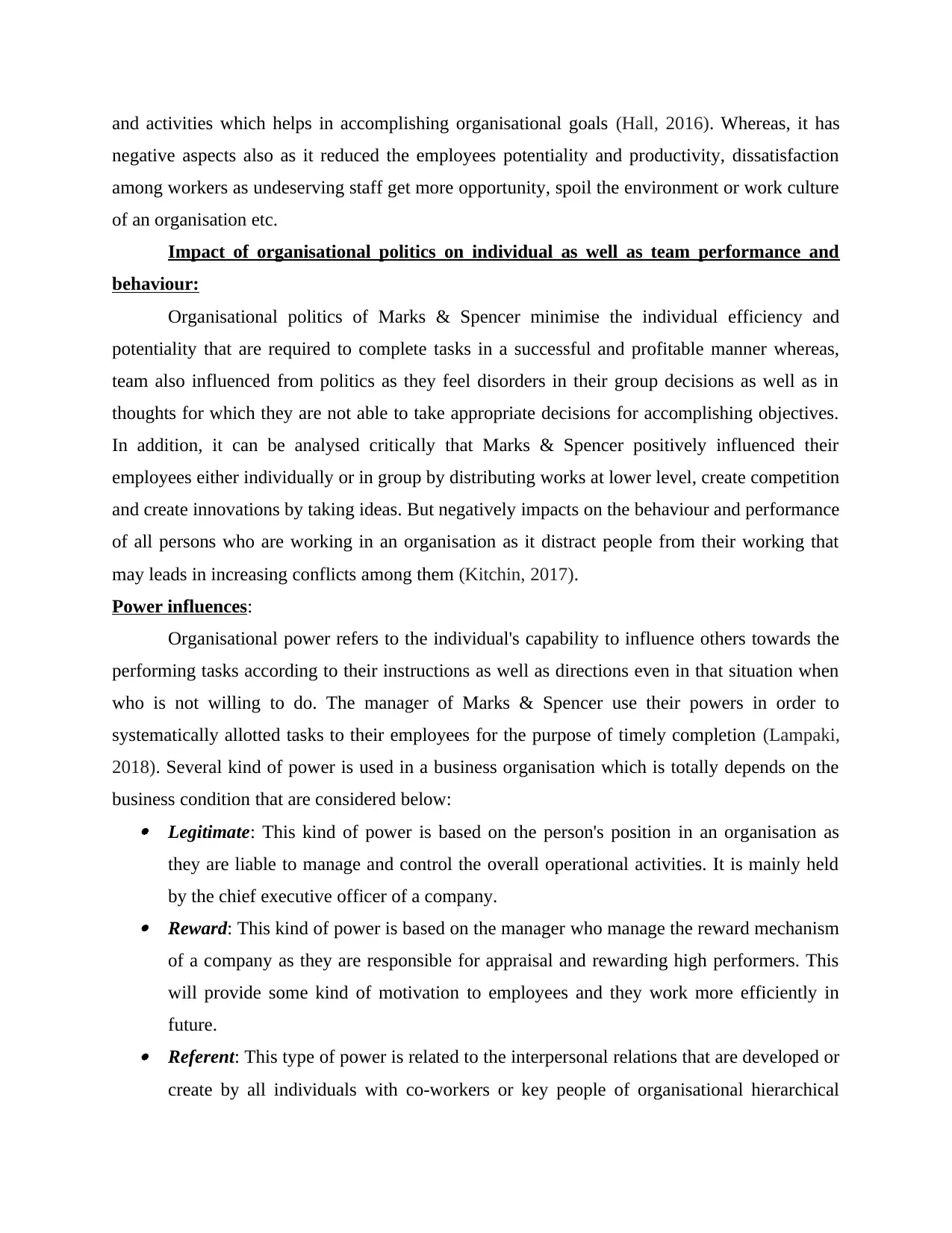
and activities which helps in accomplishing organisational goals (Hall, 2016). Whereas, it has
negative aspects also as it reduced the employees potentiality and productivity, dissatisfaction
among workers as undeserving staff get more opportunity, spoil the environment or work culture
of an organisation etc.
Impact of organisational politics on individual as well as team performance and
behaviour:
Organisational politics of Marks & Spencer minimise the individual efficiency and
potentiality that are required to complete tasks in a successful and profitable manner whereas,
team also influenced from politics as they feel disorders in their group decisions as well as in
thoughts for which they are not able to take appropriate decisions for accomplishing objectives.
In addition, it can be analysed critically that Marks & Spencer positively influenced their
employees either individually or in group by distributing works at lower level, create competition
and create innovations by taking ideas. But negatively impacts on the behaviour and performance
of all persons who are working in an organisation as it distract people from their working that
may leads in increasing conflicts among them (Kitchin, 2017).
Power influences:
Organisational power refers to the individual's capability to influence others towards the
performing tasks according to their instructions as well as directions even in that situation when
who is not willing to do. The manager of Marks & Spencer use their powers in order to
systematically allotted tasks to their employees for the purpose of timely completion (Lampaki,
2018). Several kind of power is used in a business organisation which is totally depends on the
business condition that are considered below: Legitimate: This kind of power is based on the person's position in an organisation as
they are liable to manage and control the overall operational activities. It is mainly held
by the chief executive officer of a company. Reward: This kind of power is based on the manager who manage the reward mechanism
of a company as they are responsible for appraisal and rewarding high performers. This
will provide some kind of motivation to employees and they work more efficiently in
future. Referent: This type of power is related to the interpersonal relations that are developed or
create by all individuals with co-workers or key people of organisational hierarchical
negative aspects also as it reduced the employees potentiality and productivity, dissatisfaction
among workers as undeserving staff get more opportunity, spoil the environment or work culture
of an organisation etc.
Impact of organisational politics on individual as well as team performance and
behaviour:
Organisational politics of Marks & Spencer minimise the individual efficiency and
potentiality that are required to complete tasks in a successful and profitable manner whereas,
team also influenced from politics as they feel disorders in their group decisions as well as in
thoughts for which they are not able to take appropriate decisions for accomplishing objectives.
In addition, it can be analysed critically that Marks & Spencer positively influenced their
employees either individually or in group by distributing works at lower level, create competition
and create innovations by taking ideas. But negatively impacts on the behaviour and performance
of all persons who are working in an organisation as it distract people from their working that
may leads in increasing conflicts among them (Kitchin, 2017).
Power influences:
Organisational power refers to the individual's capability to influence others towards the
performing tasks according to their instructions as well as directions even in that situation when
who is not willing to do. The manager of Marks & Spencer use their powers in order to
systematically allotted tasks to their employees for the purpose of timely completion (Lampaki,
2018). Several kind of power is used in a business organisation which is totally depends on the
business condition that are considered below: Legitimate: This kind of power is based on the person's position in an organisation as
they are liable to manage and control the overall operational activities. It is mainly held
by the chief executive officer of a company. Reward: This kind of power is based on the manager who manage the reward mechanism
of a company as they are responsible for appraisal and rewarding high performers. This
will provide some kind of motivation to employees and they work more efficiently in
future. Referent: This type of power is related to the interpersonal relations that are developed or
create by all individuals with co-workers or key people of organisational hierarchical
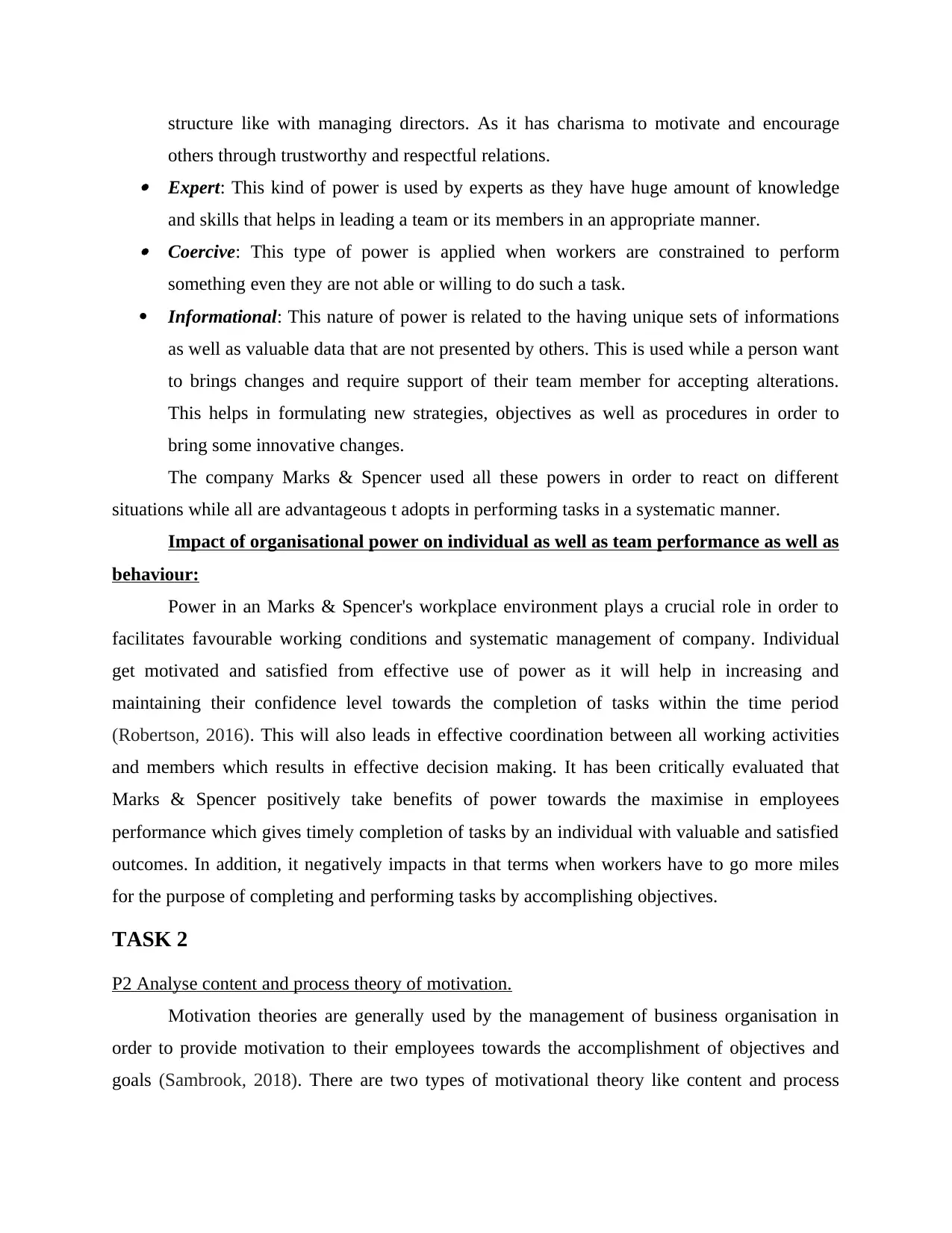
structure like with managing directors. As it has charisma to motivate and encourage
others through trustworthy and respectful relations. Expert: This kind of power is used by experts as they have huge amount of knowledge
and skills that helps in leading a team or its members in an appropriate manner. Coercive: This type of power is applied when workers are constrained to perform
something even they are not able or willing to do such a task.
Informational: This nature of power is related to the having unique sets of informations
as well as valuable data that are not presented by others. This is used while a person want
to brings changes and require support of their team member for accepting alterations.
This helps in formulating new strategies, objectives as well as procedures in order to
bring some innovative changes.
The company Marks & Spencer used all these powers in order to react on different
situations while all are advantageous t adopts in performing tasks in a systematic manner.
Impact of organisational power on individual as well as team performance as well as
behaviour:
Power in an Marks & Spencer's workplace environment plays a crucial role in order to
facilitates favourable working conditions and systematic management of company. Individual
get motivated and satisfied from effective use of power as it will help in increasing and
maintaining their confidence level towards the completion of tasks within the time period
(Robertson, 2016). This will also leads in effective coordination between all working activities
and members which results in effective decision making. It has been critically evaluated that
Marks & Spencer positively take benefits of power towards the maximise in employees
performance which gives timely completion of tasks by an individual with valuable and satisfied
outcomes. In addition, it negatively impacts in that terms when workers have to go more miles
for the purpose of completing and performing tasks by accomplishing objectives.
TASK 2
P2 Analyse content and process theory of motivation.
Motivation theories are generally used by the management of business organisation in
order to provide motivation to their employees towards the accomplishment of objectives and
goals (Sambrook, 2018). There are two types of motivational theory like content and process
others through trustworthy and respectful relations. Expert: This kind of power is used by experts as they have huge amount of knowledge
and skills that helps in leading a team or its members in an appropriate manner. Coercive: This type of power is applied when workers are constrained to perform
something even they are not able or willing to do such a task.
Informational: This nature of power is related to the having unique sets of informations
as well as valuable data that are not presented by others. This is used while a person want
to brings changes and require support of their team member for accepting alterations.
This helps in formulating new strategies, objectives as well as procedures in order to
bring some innovative changes.
The company Marks & Spencer used all these powers in order to react on different
situations while all are advantageous t adopts in performing tasks in a systematic manner.
Impact of organisational power on individual as well as team performance as well as
behaviour:
Power in an Marks & Spencer's workplace environment plays a crucial role in order to
facilitates favourable working conditions and systematic management of company. Individual
get motivated and satisfied from effective use of power as it will help in increasing and
maintaining their confidence level towards the completion of tasks within the time period
(Robertson, 2016). This will also leads in effective coordination between all working activities
and members which results in effective decision making. It has been critically evaluated that
Marks & Spencer positively take benefits of power towards the maximise in employees
performance which gives timely completion of tasks by an individual with valuable and satisfied
outcomes. In addition, it negatively impacts in that terms when workers have to go more miles
for the purpose of completing and performing tasks by accomplishing objectives.
TASK 2
P2 Analyse content and process theory of motivation.
Motivation theories are generally used by the management of business organisation in
order to provide motivation to their employees towards the accomplishment of objectives and
goals (Sambrook, 2018). There are two types of motivational theory like content and process
⊘ This is a preview!⊘
Do you want full access?
Subscribe today to unlock all pages.

Trusted by 1+ million students worldwide
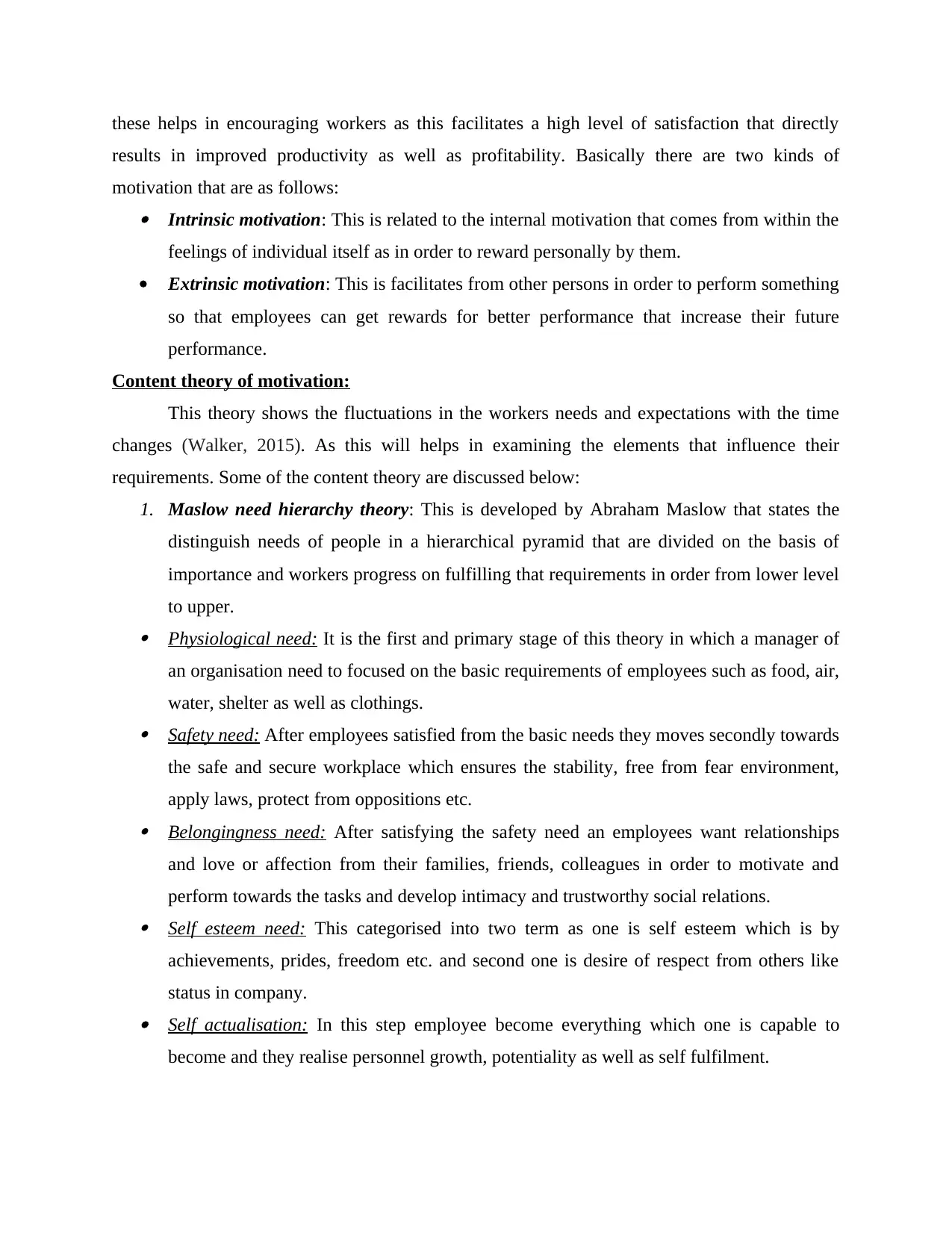
these helps in encouraging workers as this facilitates a high level of satisfaction that directly
results in improved productivity as well as profitability. Basically there are two kinds of
motivation that are as follows: Intrinsic motivation: This is related to the internal motivation that comes from within the
feelings of individual itself as in order to reward personally by them.
Extrinsic motivation: This is facilitates from other persons in order to perform something
so that employees can get rewards for better performance that increase their future
performance.
Content theory of motivation:
This theory shows the fluctuations in the workers needs and expectations with the time
changes (Walker, 2015). As this will helps in examining the elements that influence their
requirements. Some of the content theory are discussed below:
1. Maslow need hierarchy theory: This is developed by Abraham Maslow that states the
distinguish needs of people in a hierarchical pyramid that are divided on the basis of
importance and workers progress on fulfilling that requirements in order from lower level
to upper. Physiological need: It is the first and primary stage of this theory in which a manager of
an organisation need to focused on the basic requirements of employees such as food, air,
water, shelter as well as clothings. Safety need: After employees satisfied from the basic needs they moves secondly towards
the safe and secure workplace which ensures the stability, free from fear environment,
apply laws, protect from oppositions etc. Belongingness need: After satisfying the safety need an employees want relationships
and love or affection from their families, friends, colleagues in order to motivate and
perform towards the tasks and develop intimacy and trustworthy social relations. Self esteem need: This categorised into two term as one is self esteem which is by
achievements, prides, freedom etc. and second one is desire of respect from others like
status in company. Self actualisation: In this step employee become everything which one is capable to
become and they realise personnel growth, potentiality as well as self fulfilment.
results in improved productivity as well as profitability. Basically there are two kinds of
motivation that are as follows: Intrinsic motivation: This is related to the internal motivation that comes from within the
feelings of individual itself as in order to reward personally by them.
Extrinsic motivation: This is facilitates from other persons in order to perform something
so that employees can get rewards for better performance that increase their future
performance.
Content theory of motivation:
This theory shows the fluctuations in the workers needs and expectations with the time
changes (Walker, 2015). As this will helps in examining the elements that influence their
requirements. Some of the content theory are discussed below:
1. Maslow need hierarchy theory: This is developed by Abraham Maslow that states the
distinguish needs of people in a hierarchical pyramid that are divided on the basis of
importance and workers progress on fulfilling that requirements in order from lower level
to upper. Physiological need: It is the first and primary stage of this theory in which a manager of
an organisation need to focused on the basic requirements of employees such as food, air,
water, shelter as well as clothings. Safety need: After employees satisfied from the basic needs they moves secondly towards
the safe and secure workplace which ensures the stability, free from fear environment,
apply laws, protect from oppositions etc. Belongingness need: After satisfying the safety need an employees want relationships
and love or affection from their families, friends, colleagues in order to motivate and
perform towards the tasks and develop intimacy and trustworthy social relations. Self esteem need: This categorised into two term as one is self esteem which is by
achievements, prides, freedom etc. and second one is desire of respect from others like
status in company. Self actualisation: In this step employee become everything which one is capable to
become and they realise personnel growth, potentiality as well as self fulfilment.
Paraphrase This Document
Need a fresh take? Get an instant paraphrase of this document with our AI Paraphraser
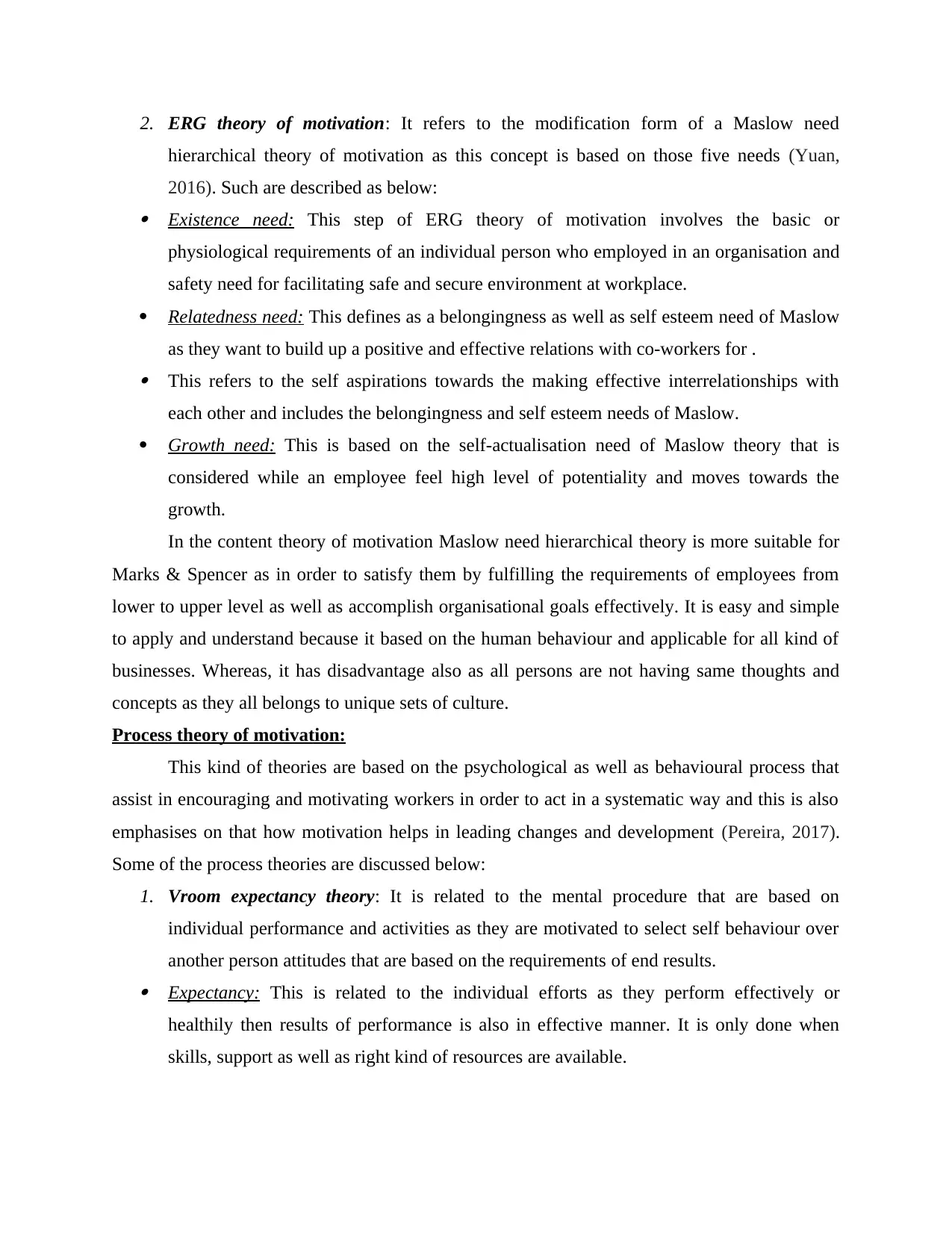
2. ERG theory of motivation: It refers to the modification form of a Maslow need
hierarchical theory of motivation as this concept is based on those five needs (Yuan,
2016). Such are described as below: Existence need: This step of ERG theory of motivation involves the basic or
physiological requirements of an individual person who employed in an organisation and
safety need for facilitating safe and secure environment at workplace.
Relatedness need: This defines as a belongingness as well as self esteem need of Maslow
as they want to build up a positive and effective relations with co-workers for . This refers to the self aspirations towards the making effective interrelationships with
each other and includes the belongingness and self esteem needs of Maslow.
Growth need: This is based on the self-actualisation need of Maslow theory that is
considered while an employee feel high level of potentiality and moves towards the
growth.
In the content theory of motivation Maslow need hierarchical theory is more suitable for
Marks & Spencer as in order to satisfy them by fulfilling the requirements of employees from
lower to upper level as well as accomplish organisational goals effectively. It is easy and simple
to apply and understand because it based on the human behaviour and applicable for all kind of
businesses. Whereas, it has disadvantage also as all persons are not having same thoughts and
concepts as they all belongs to unique sets of culture.
Process theory of motivation:
This kind of theories are based on the psychological as well as behavioural process that
assist in encouraging and motivating workers in order to act in a systematic way and this is also
emphasises on that how motivation helps in leading changes and development (Pereira, 2017).
Some of the process theories are discussed below:
1. Vroom expectancy theory: It is related to the mental procedure that are based on
individual performance and activities as they are motivated to select self behaviour over
another person attitudes that are based on the requirements of end results. Expectancy: This is related to the individual efforts as they perform effectively or
healthily then results of performance is also in effective manner. It is only done when
skills, support as well as right kind of resources are available.
hierarchical theory of motivation as this concept is based on those five needs (Yuan,
2016). Such are described as below: Existence need: This step of ERG theory of motivation involves the basic or
physiological requirements of an individual person who employed in an organisation and
safety need for facilitating safe and secure environment at workplace.
Relatedness need: This defines as a belongingness as well as self esteem need of Maslow
as they want to build up a positive and effective relations with co-workers for . This refers to the self aspirations towards the making effective interrelationships with
each other and includes the belongingness and self esteem needs of Maslow.
Growth need: This is based on the self-actualisation need of Maslow theory that is
considered while an employee feel high level of potentiality and moves towards the
growth.
In the content theory of motivation Maslow need hierarchical theory is more suitable for
Marks & Spencer as in order to satisfy them by fulfilling the requirements of employees from
lower to upper level as well as accomplish organisational goals effectively. It is easy and simple
to apply and understand because it based on the human behaviour and applicable for all kind of
businesses. Whereas, it has disadvantage also as all persons are not having same thoughts and
concepts as they all belongs to unique sets of culture.
Process theory of motivation:
This kind of theories are based on the psychological as well as behavioural process that
assist in encouraging and motivating workers in order to act in a systematic way and this is also
emphasises on that how motivation helps in leading changes and development (Pereira, 2017).
Some of the process theories are discussed below:
1. Vroom expectancy theory: It is related to the mental procedure that are based on
individual performance and activities as they are motivated to select self behaviour over
another person attitudes that are based on the requirements of end results. Expectancy: This is related to the individual efforts as they perform effectively or
healthily then results of performance is also in effective manner. It is only done when
skills, support as well as right kind of resources are available.
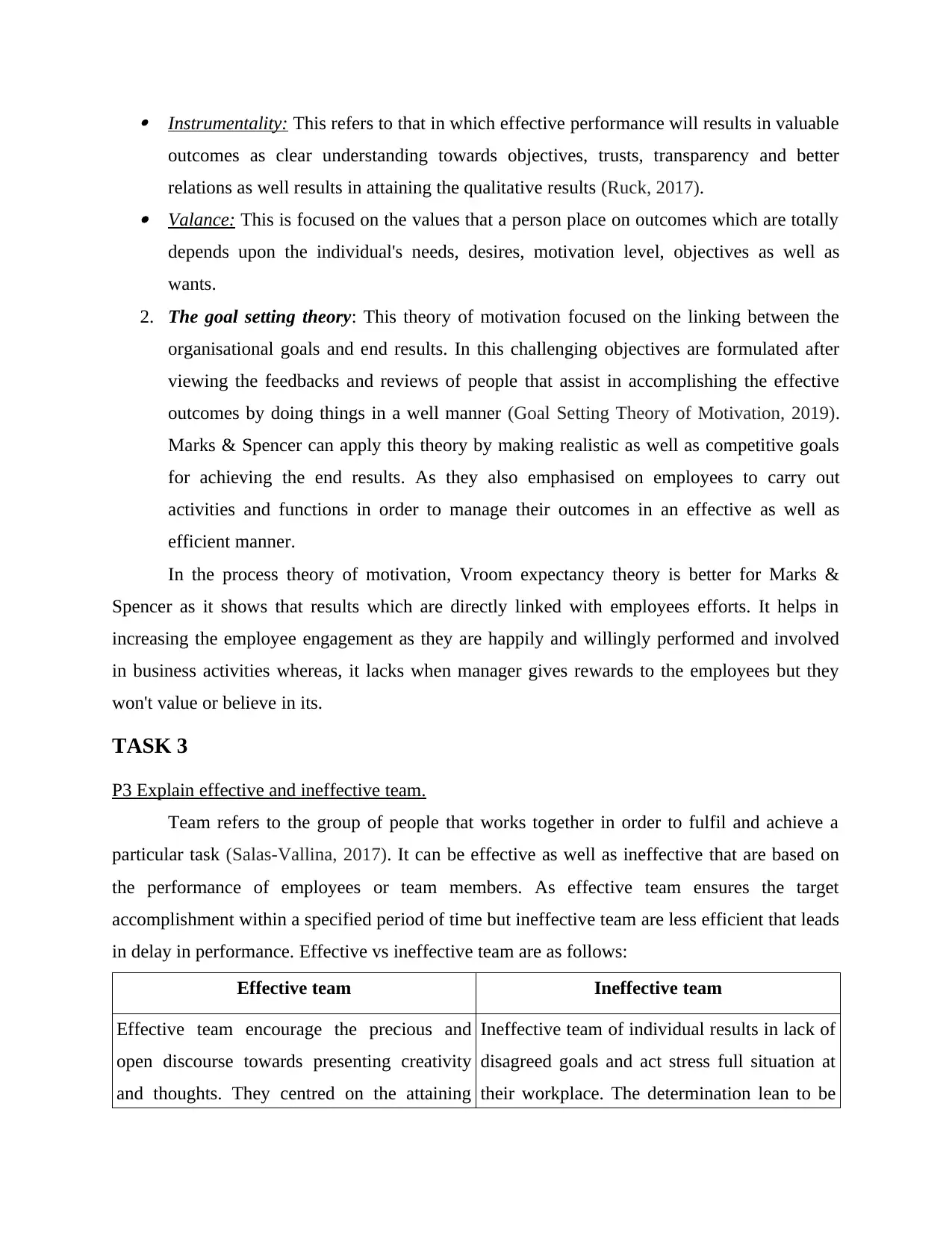
Instrumentality: This refers to that in which effective performance will results in valuable
outcomes as clear understanding towards objectives, trusts, transparency and better
relations as well results in attaining the qualitative results (Ruck, 2017). Valance: This is focused on the values that a person place on outcomes which are totally
depends upon the individual's needs, desires, motivation level, objectives as well as
wants.
2. The goal setting theory: This theory of motivation focused on the linking between the
organisational goals and end results. In this challenging objectives are formulated after
viewing the feedbacks and reviews of people that assist in accomplishing the effective
outcomes by doing things in a well manner (Goal Setting Theory of Motivation, 2019).
Marks & Spencer can apply this theory by making realistic as well as competitive goals
for achieving the end results. As they also emphasised on employees to carry out
activities and functions in order to manage their outcomes in an effective as well as
efficient manner.
In the process theory of motivation, Vroom expectancy theory is better for Marks &
Spencer as it shows that results which are directly linked with employees efforts. It helps in
increasing the employee engagement as they are happily and willingly performed and involved
in business activities whereas, it lacks when manager gives rewards to the employees but they
won't value or believe in its.
TASK 3
P3 Explain effective and ineffective team.
Team refers to the group of people that works together in order to fulfil and achieve a
particular task (Salas-Vallina, 2017). It can be effective as well as ineffective that are based on
the performance of employees or team members. As effective team ensures the target
accomplishment within a specified period of time but ineffective team are less efficient that leads
in delay in performance. Effective vs ineffective team are as follows:
Effective team Ineffective team
Effective team encourage the precious and
open discourse towards presenting creativity
and thoughts. They centred on the attaining
Ineffective team of individual results in lack of
disagreed goals and act stress full situation at
their workplace. The determination lean to be
outcomes as clear understanding towards objectives, trusts, transparency and better
relations as well results in attaining the qualitative results (Ruck, 2017). Valance: This is focused on the values that a person place on outcomes which are totally
depends upon the individual's needs, desires, motivation level, objectives as well as
wants.
2. The goal setting theory: This theory of motivation focused on the linking between the
organisational goals and end results. In this challenging objectives are formulated after
viewing the feedbacks and reviews of people that assist in accomplishing the effective
outcomes by doing things in a well manner (Goal Setting Theory of Motivation, 2019).
Marks & Spencer can apply this theory by making realistic as well as competitive goals
for achieving the end results. As they also emphasised on employees to carry out
activities and functions in order to manage their outcomes in an effective as well as
efficient manner.
In the process theory of motivation, Vroom expectancy theory is better for Marks &
Spencer as it shows that results which are directly linked with employees efforts. It helps in
increasing the employee engagement as they are happily and willingly performed and involved
in business activities whereas, it lacks when manager gives rewards to the employees but they
won't value or believe in its.
TASK 3
P3 Explain effective and ineffective team.
Team refers to the group of people that works together in order to fulfil and achieve a
particular task (Salas-Vallina, 2017). It can be effective as well as ineffective that are based on
the performance of employees or team members. As effective team ensures the target
accomplishment within a specified period of time but ineffective team are less efficient that leads
in delay in performance. Effective vs ineffective team are as follows:
Effective team Ineffective team
Effective team encourage the precious and
open discourse towards presenting creativity
and thoughts. They centred on the attaining
Ineffective team of individual results in lack of
disagreed goals and act stress full situation at
their workplace. The determination lean to be
⊘ This is a preview!⊘
Do you want full access?
Subscribe today to unlock all pages.

Trusted by 1+ million students worldwide
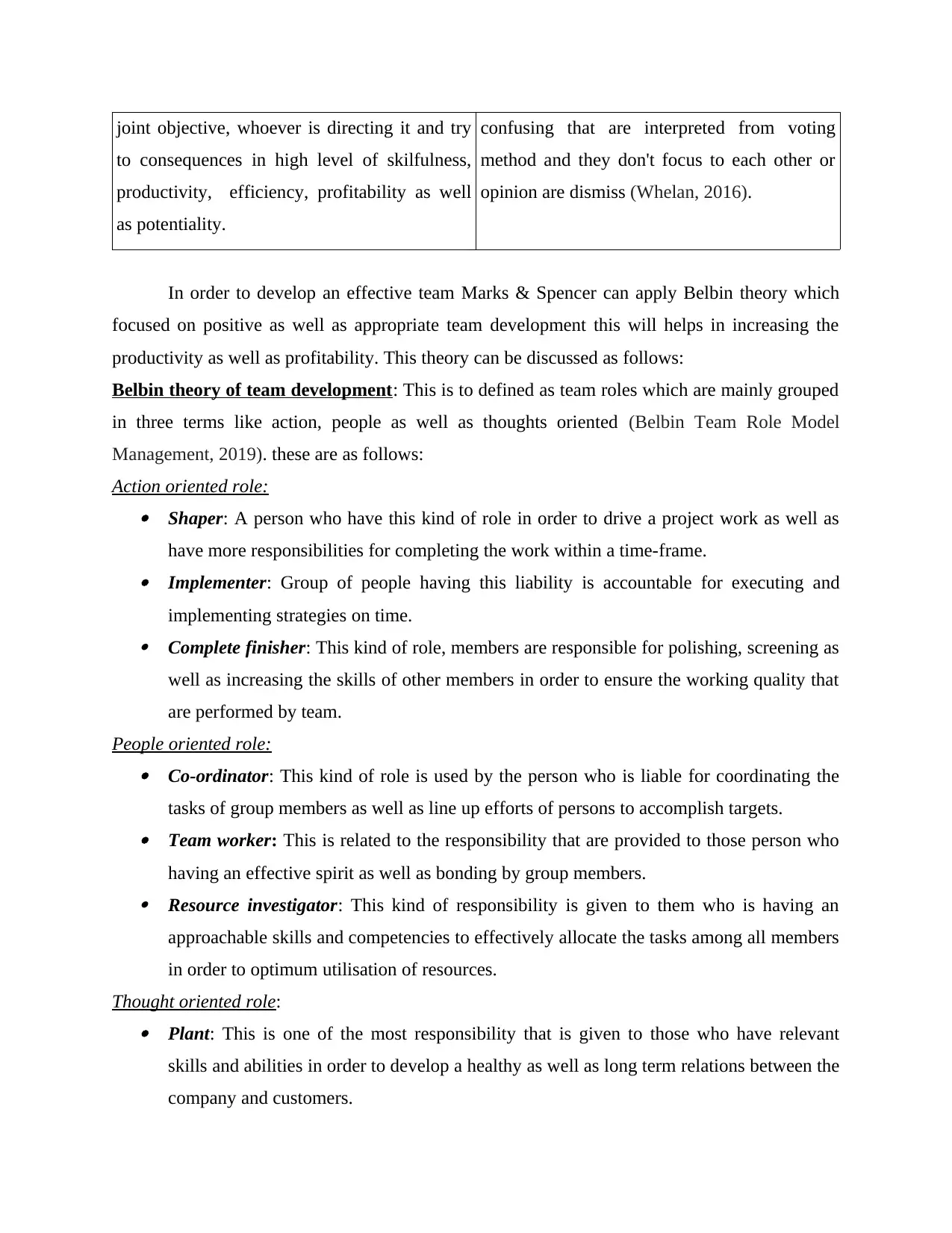
joint objective, whoever is directing it and try
to consequences in high level of skilfulness,
productivity, efficiency, profitability as well
as potentiality.
confusing that are interpreted from voting
method and they don't focus to each other or
opinion are dismiss (Whelan, 2016).
In order to develop an effective team Marks & Spencer can apply Belbin theory which
focused on positive as well as appropriate team development this will helps in increasing the
productivity as well as profitability. This theory can be discussed as follows:
Belbin theory of team development: This is to defined as team roles which are mainly grouped
in three terms like action, people as well as thoughts oriented (Belbin Team Role Model
Management, 2019). these are as follows:
Action oriented role: Shaper: A person who have this kind of role in order to drive a project work as well as
have more responsibilities for completing the work within a time-frame. Implementer: Group of people having this liability is accountable for executing and
implementing strategies on time. Complete finisher: This kind of role, members are responsible for polishing, screening as
well as increasing the skills of other members in order to ensure the working quality that
are performed by team.
People oriented role: Co-ordinator: This kind of role is used by the person who is liable for coordinating the
tasks of group members as well as line up efforts of persons to accomplish targets. Team worker: This is related to the responsibility that are provided to those person who
having an effective spirit as well as bonding by group members. Resource investigator: This kind of responsibility is given to them who is having an
approachable skills and competencies to effectively allocate the tasks among all members
in order to optimum utilisation of resources.
Thought oriented role: Plant: This is one of the most responsibility that is given to those who have relevant
skills and abilities in order to develop a healthy as well as long term relations between the
company and customers.
to consequences in high level of skilfulness,
productivity, efficiency, profitability as well
as potentiality.
confusing that are interpreted from voting
method and they don't focus to each other or
opinion are dismiss (Whelan, 2016).
In order to develop an effective team Marks & Spencer can apply Belbin theory which
focused on positive as well as appropriate team development this will helps in increasing the
productivity as well as profitability. This theory can be discussed as follows:
Belbin theory of team development: This is to defined as team roles which are mainly grouped
in three terms like action, people as well as thoughts oriented (Belbin Team Role Model
Management, 2019). these are as follows:
Action oriented role: Shaper: A person who have this kind of role in order to drive a project work as well as
have more responsibilities for completing the work within a time-frame. Implementer: Group of people having this liability is accountable for executing and
implementing strategies on time. Complete finisher: This kind of role, members are responsible for polishing, screening as
well as increasing the skills of other members in order to ensure the working quality that
are performed by team.
People oriented role: Co-ordinator: This kind of role is used by the person who is liable for coordinating the
tasks of group members as well as line up efforts of persons to accomplish targets. Team worker: This is related to the responsibility that are provided to those person who
having an effective spirit as well as bonding by group members. Resource investigator: This kind of responsibility is given to them who is having an
approachable skills and competencies to effectively allocate the tasks among all members
in order to optimum utilisation of resources.
Thought oriented role: Plant: This is one of the most responsibility that is given to those who have relevant
skills and abilities in order to develop a healthy as well as long term relations between the
company and customers.
Paraphrase This Document
Need a fresh take? Get an instant paraphrase of this document with our AI Paraphraser
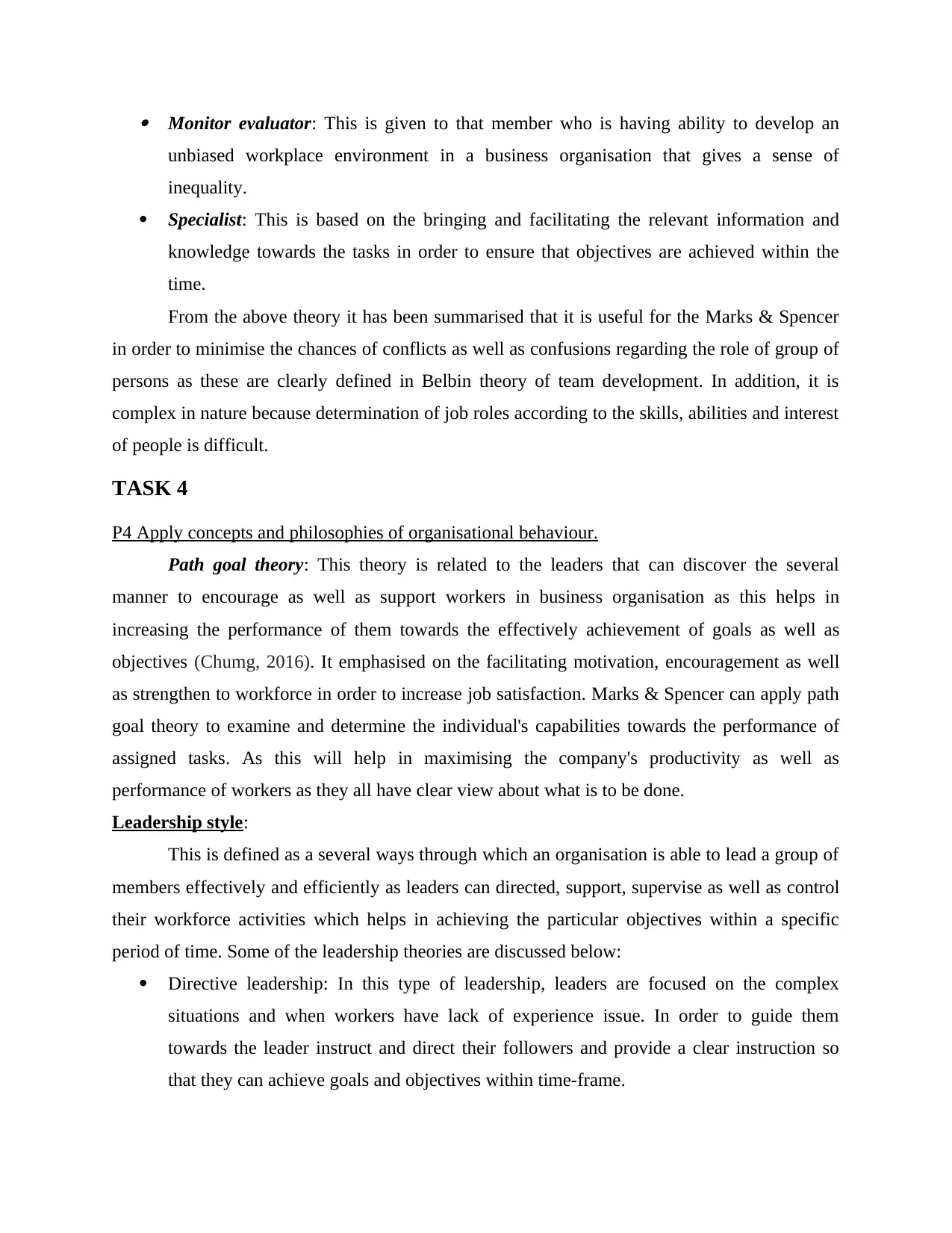
Monitor evaluator: This is given to that member who is having ability to develop an
unbiased workplace environment in a business organisation that gives a sense of
inequality.
Specialist: This is based on the bringing and facilitating the relevant information and
knowledge towards the tasks in order to ensure that objectives are achieved within the
time.
From the above theory it has been summarised that it is useful for the Marks & Spencer
in order to minimise the chances of conflicts as well as confusions regarding the role of group of
persons as these are clearly defined in Belbin theory of team development. In addition, it is
complex in nature because determination of job roles according to the skills, abilities and interest
of people is difficult.
TASK 4
P4 Apply concepts and philosophies of organisational behaviour.
Path goal theory: This theory is related to the leaders that can discover the several
manner to encourage as well as support workers in business organisation as this helps in
increasing the performance of them towards the effectively achievement of goals as well as
objectives (Chumg, 2016). It emphasised on the facilitating motivation, encouragement as well
as strengthen to workforce in order to increase job satisfaction. Marks & Spencer can apply path
goal theory to examine and determine the individual's capabilities towards the performance of
assigned tasks. As this will help in maximising the company's productivity as well as
performance of workers as they all have clear view about what is to be done.
Leadership style:
This is defined as a several ways through which an organisation is able to lead a group of
members effectively and efficiently as leaders can directed, support, supervise as well as control
their workforce activities which helps in achieving the particular objectives within a specific
period of time. Some of the leadership theories are discussed below:
Directive leadership: In this type of leadership, leaders are focused on the complex
situations and when workers have lack of experience issue. In order to guide them
towards the leader instruct and direct their followers and provide a clear instruction so
that they can achieve goals and objectives within time-frame.
unbiased workplace environment in a business organisation that gives a sense of
inequality.
Specialist: This is based on the bringing and facilitating the relevant information and
knowledge towards the tasks in order to ensure that objectives are achieved within the
time.
From the above theory it has been summarised that it is useful for the Marks & Spencer
in order to minimise the chances of conflicts as well as confusions regarding the role of group of
persons as these are clearly defined in Belbin theory of team development. In addition, it is
complex in nature because determination of job roles according to the skills, abilities and interest
of people is difficult.
TASK 4
P4 Apply concepts and philosophies of organisational behaviour.
Path goal theory: This theory is related to the leaders that can discover the several
manner to encourage as well as support workers in business organisation as this helps in
increasing the performance of them towards the effectively achievement of goals as well as
objectives (Chumg, 2016). It emphasised on the facilitating motivation, encouragement as well
as strengthen to workforce in order to increase job satisfaction. Marks & Spencer can apply path
goal theory to examine and determine the individual's capabilities towards the performance of
assigned tasks. As this will help in maximising the company's productivity as well as
performance of workers as they all have clear view about what is to be done.
Leadership style:
This is defined as a several ways through which an organisation is able to lead a group of
members effectively and efficiently as leaders can directed, support, supervise as well as control
their workforce activities which helps in achieving the particular objectives within a specific
period of time. Some of the leadership theories are discussed below:
Directive leadership: In this type of leadership, leaders are focused on the complex
situations and when workers have lack of experience issue. In order to guide them
towards the leader instruct and direct their followers and provide a clear instruction so
that they can achieve goals and objectives within time-frame.
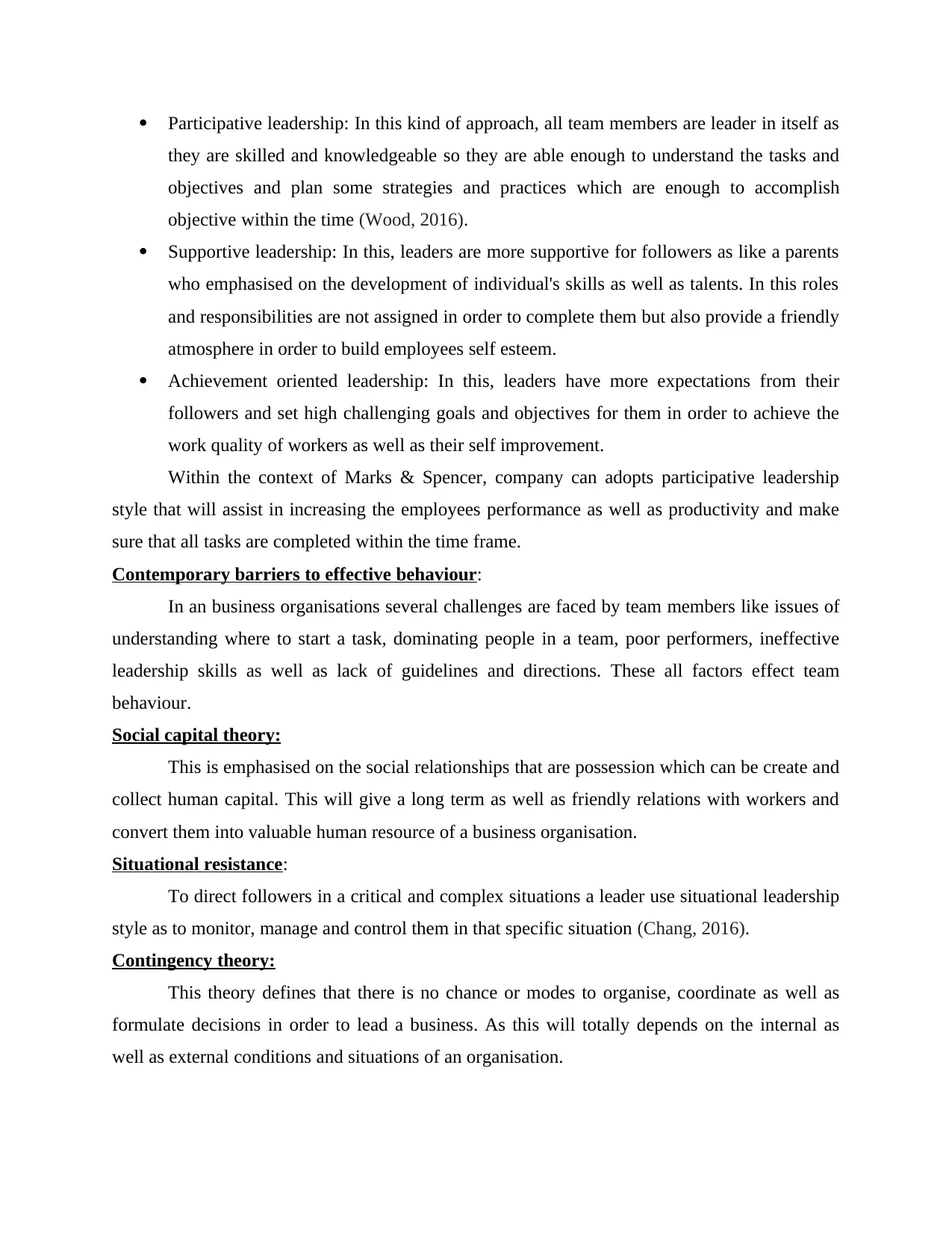
Participative leadership: In this kind of approach, all team members are leader in itself as
they are skilled and knowledgeable so they are able enough to understand the tasks and
objectives and plan some strategies and practices which are enough to accomplish
objective within the time (Wood, 2016).
Supportive leadership: In this, leaders are more supportive for followers as like a parents
who emphasised on the development of individual's skills as well as talents. In this roles
and responsibilities are not assigned in order to complete them but also provide a friendly
atmosphere in order to build employees self esteem.
Achievement oriented leadership: In this, leaders have more expectations from their
followers and set high challenging goals and objectives for them in order to achieve the
work quality of workers as well as their self improvement.
Within the context of Marks & Spencer, company can adopts participative leadership
style that will assist in increasing the employees performance as well as productivity and make
sure that all tasks are completed within the time frame.
Contemporary barriers to effective behaviour:
In an business organisations several challenges are faced by team members like issues of
understanding where to start a task, dominating people in a team, poor performers, ineffective
leadership skills as well as lack of guidelines and directions. These all factors effect team
behaviour.
Social capital theory:
This is emphasised on the social relationships that are possession which can be create and
collect human capital. This will give a long term as well as friendly relations with workers and
convert them into valuable human resource of a business organisation.
Situational resistance:
To direct followers in a critical and complex situations a leader use situational leadership
style as to monitor, manage and control them in that specific situation (Chang, 2016).
Contingency theory:
This theory defines that there is no chance or modes to organise, coordinate as well as
formulate decisions in order to lead a business. As this will totally depends on the internal as
well as external conditions and situations of an organisation.
they are skilled and knowledgeable so they are able enough to understand the tasks and
objectives and plan some strategies and practices which are enough to accomplish
objective within the time (Wood, 2016).
Supportive leadership: In this, leaders are more supportive for followers as like a parents
who emphasised on the development of individual's skills as well as talents. In this roles
and responsibilities are not assigned in order to complete them but also provide a friendly
atmosphere in order to build employees self esteem.
Achievement oriented leadership: In this, leaders have more expectations from their
followers and set high challenging goals and objectives for them in order to achieve the
work quality of workers as well as their self improvement.
Within the context of Marks & Spencer, company can adopts participative leadership
style that will assist in increasing the employees performance as well as productivity and make
sure that all tasks are completed within the time frame.
Contemporary barriers to effective behaviour:
In an business organisations several challenges are faced by team members like issues of
understanding where to start a task, dominating people in a team, poor performers, ineffective
leadership skills as well as lack of guidelines and directions. These all factors effect team
behaviour.
Social capital theory:
This is emphasised on the social relationships that are possession which can be create and
collect human capital. This will give a long term as well as friendly relations with workers and
convert them into valuable human resource of a business organisation.
Situational resistance:
To direct followers in a critical and complex situations a leader use situational leadership
style as to monitor, manage and control them in that specific situation (Chang, 2016).
Contingency theory:
This theory defines that there is no chance or modes to organise, coordinate as well as
formulate decisions in order to lead a business. As this will totally depends on the internal as
well as external conditions and situations of an organisation.
⊘ This is a preview!⊘
Do you want full access?
Subscribe today to unlock all pages.

Trusted by 1+ million students worldwide
1 out of 15
Related Documents
Your All-in-One AI-Powered Toolkit for Academic Success.
+13062052269
info@desklib.com
Available 24*7 on WhatsApp / Email
![[object Object]](/_next/static/media/star-bottom.7253800d.svg)
Unlock your academic potential
Copyright © 2020–2025 A2Z Services. All Rights Reserved. Developed and managed by ZUCOL.




